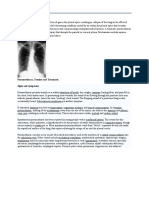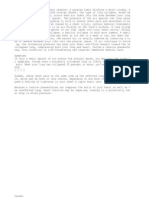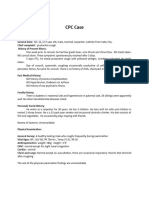0 ratings0% found this document useful (0 votes)
41 viewsView Media Gallery
View Media Gallery
Uploaded by
Dhiya RahadianPneumothorax is the presence of air in the pleural cavity between the lungs and chest wall. It can impair breathing and circulation. Air enters through the chest wall from trauma or through the lung tissue. Symptoms range from none to life-threatening and depend on the type and size of pneumothorax. A physical exam may reveal shortness of breath, decreased or absent breath sounds, and a shift of the heart away from the affected side. Chest x-rays are required for diagnosis.
Copyright:
© All Rights Reserved
Available Formats
Download as DOCX, PDF, TXT or read online from Scribd
View Media Gallery
View Media Gallery
Uploaded by
Dhiya Rahadian0 ratings0% found this document useful (0 votes)
41 views2 pagesPneumothorax is the presence of air in the pleural cavity between the lungs and chest wall. It can impair breathing and circulation. Air enters through the chest wall from trauma or through the lung tissue. Symptoms range from none to life-threatening and depend on the type and size of pneumothorax. A physical exam may reveal shortness of breath, decreased or absent breath sounds, and a shift of the heart away from the affected side. Chest x-rays are required for diagnosis.
Original Description:
pneumotoraks
Original Title
pneumothorax
Copyright
© © All Rights Reserved
Available Formats
DOCX, PDF, TXT or read online from Scribd
Share this document
Did you find this document useful?
Is this content inappropriate?
Pneumothorax is the presence of air in the pleural cavity between the lungs and chest wall. It can impair breathing and circulation. Air enters through the chest wall from trauma or through the lung tissue. Symptoms range from none to life-threatening and depend on the type and size of pneumothorax. A physical exam may reveal shortness of breath, decreased or absent breath sounds, and a shift of the heart away from the affected side. Chest x-rays are required for diagnosis.
Copyright:
© All Rights Reserved
Available Formats
Download as DOCX, PDF, TXT or read online from Scribd
Download as docx, pdf, or txt
0 ratings0% found this document useful (0 votes)
41 views2 pagesView Media Gallery
View Media Gallery
Uploaded by
Dhiya RahadianPneumothorax is the presence of air in the pleural cavity between the lungs and chest wall. It can impair breathing and circulation. Air enters through the chest wall from trauma or through the lung tissue. Symptoms range from none to life-threatening and depend on the type and size of pneumothorax. A physical exam may reveal shortness of breath, decreased or absent breath sounds, and a shift of the heart away from the affected side. Chest x-rays are required for diagnosis.
Copyright:
© All Rights Reserved
Available Formats
Download as DOCX, PDF, TXT or read online from Scribd
Download as docx, pdf, or txt
You are on page 1of 2
Practice Essentials
Pneumothorax is defined as the presence of air or gas in the pleural
cavity (ie, the potential space between the visceral and parietal pleura of
the lung), which can impair oxygenation and/or ventilation. The clinical
results are dependent on the degree of collapse of the lung on the
affected side. If the pneumothorax is significant, it can cause a shift of the
mediastinum and compromise hemodynamic stability. Air can enter the
intrapleural space through a communication from the chest wall (ie,
trauma) or through the lung parenchyma across the visceral pleura. See
the image below.
Radiograph of a patient with a
complete right-sided pneumothorax due to a stab wound.
View Media Gallery
Signs and symptoms
The presentation of patients with pneumothorax varies depending on the
following types of pneumothorax and ranges from completely
asymptomatic to life-threatening respiratory distress:
Spontaneous pneumothorax: No clinical signs or symptoms in
primary spontaneous pneumothorax until a bleb ruptures and causes
pneumothorax; typically, the result is acute onset of chest pain and
shortness of breath, particularly with secondary spontaneous
pneumothoraces
Iatrogenic pneumothorax: Symptoms similar to those of spontaneous
pneumothorax, depending on patient’s age, presence of underlying
lung disease, and extent of pneumothorax
Tension pneumothorax: Hypotension, hypoxia, chest pain, dyspnea
Catamenial pneumothorax: Women aged 30-40 years with onset of
symptoms within 48 hours of menstruation, right-sided
pneumothorax, and recurrence
Pneumomediastinum: Must be differentiated from spontaneous
pneumothorax; patients may or may not have symptoms of chest
pain, persistent cough, sore throat, dysphagia, shortness of breath,
or nausea/vomiting
See Clinical Presentation for more detail.
Diagnosis
History and physical examination remain the keys to making the
diagnosis of pneumothorax. Examination of patients with this condition
may reveal diaphoresis and cyanosis (in the case of tension
pneumothorax). Affected patients may also reveal altered mental status
changes, including decreased alertness and/or consciousness (a rare
finding).
Findings on lung auscultation vary depending on the extent of the
pneumothorax. Respiratory findings may include the following:
Respiratory distress (considered a universal finding) or respiratory
arrest
Tachypnea (or bradypnea as a preterminal event)
Asymmetric lung expansion: Mediastinal and tracheal shift to
contralateral side (large tension pneumothorax)
Distant or absent breath sounds: Unilaterally decreased/absent lung
sounds common, but decreased air entry may be absent even in
advanced state of pneumothorax
Minimal lung sounds transmitted from unaffected hemithorax with
auscultation at midaxillary line
Hyperresonance on percussion: Rare finding; may be absent even in
an advanced state
Decreased tactile fremitus
Adventitious lung sounds: Ipsilateral crackles, wheezes
Sumber : eedicine.medscape.com
You might also like
- Pneumothorax Case FileDocument2 pagesPneumothorax Case Filehttps://medical-phd.blogspot.comNo ratings yet
- PneumothoraxDocument52 pagesPneumothoraxtrisna satrianaNo ratings yet
- Pneumothorax, Tension and TraumaticDocument29 pagesPneumothorax, Tension and TraumaticicaNo ratings yet
- Stab Wound PathophysiologyDocument5 pagesStab Wound PathophysiologyJaessa Feliciano86% (7)
- Nursing Care PlanDocument2 pagesNursing Care PlanGil John Vuiton Arsenal81% (21)
- Handbook of Palliative Medicine in MalaysiaDocument95 pagesHandbook of Palliative Medicine in Malaysiaumiraihana1No ratings yet
- Tension MedscapeDocument24 pagesTension MedscapeHandayaniNo ratings yet
- Pneumothorax 1Document4 pagesPneumothorax 1Monika AyuningrumNo ratings yet
- Pneumothorax and Pneumomediastinum: Dr. Emad EfatDocument89 pagesPneumothorax and Pneumomediastinum: Dr. Emad Efatinterna MANADONo ratings yet
- Tension Pneumothorax: History and PhysicalDocument5 pagesTension Pneumothorax: History and PhysicalKenneth AndayaNo ratings yet
- Alok Sinha Department of Medicine Manipal College of Medical Sciences Pokhara, NepalDocument46 pagesAlok Sinha Department of Medicine Manipal College of Medical Sciences Pokhara, NepalAnnushika PalanichamyNo ratings yet
- PULMO - Pleural DiseaseDocument11 pagesPULMO - Pleural DiseaseHajime NakaegawaNo ratings yet
- Pneumothorax & Hemothorax: Farshid MokhberiDocument32 pagesPneumothorax & Hemothorax: Farshid MokhberiYan Sheng HoNo ratings yet
- Pneumothorax FinalDocument62 pagesPneumothorax FinalmithramuruganNo ratings yet
- Pneumothorax: Disturbance in OxygenationDocument27 pagesPneumothorax: Disturbance in Oxygenationamier90No ratings yet
- Pneumothorax, COPD, CVDsDocument156 pagesPneumothorax, COPD, CVDsakoeljames8543No ratings yet
- Pneumothorax: Risk Factors For A PneumothoraxDocument12 pagesPneumothorax: Risk Factors For A Pneumothoraxyangi dokaNo ratings yet
- Clinical Presentation and Diagnosis of PneumothoraxDocument49 pagesClinical Presentation and Diagnosis of PneumothoraxisahNo ratings yet
- PneumothoraxDocument36 pagesPneumothoraxEira Lopez63% (8)
- PneumothoraxDocument5 pagesPneumothoraxSaiful UmamNo ratings yet
- Tension Pneumothorax by AnkurDocument30 pagesTension Pneumothorax by AnkurAnkur AgrawalNo ratings yet
- Pneumothorax, Tension and TraumaticDocument24 pagesPneumothorax, Tension and TraumaticSatria WibawaNo ratings yet
- Tension PneumothoraxDocument5 pagesTension PneumothoraxKay BristolNo ratings yet
- PneumothoraxDocument6 pagesPneumothoraxmengjapson123No ratings yet
- PneumothoraxDocument13 pagesPneumothoraxRex NamudNo ratings yet
- Disorders of The Respiratory SystemDocument9 pagesDisorders of The Respiratory SystemAjay Pal NattNo ratings yet
- Case Study For PneumothoraxDocument4 pagesCase Study For PneumothoraxGabbii CincoNo ratings yet
- Pneumothorax: Dr. Ibnu DharmajatiDocument16 pagesPneumothorax: Dr. Ibnu DharmajatiIbnu DharmajatiNo ratings yet
- PneumothoraxDocument6 pagesPneumothoraxminmin69100% (1)
- Surgery TCVS SGD Guide KKDocument7 pagesSurgery TCVS SGD Guide KKFu Xiao ShanNo ratings yet
- PneumothoraxDocument25 pagesPneumothoraxAsma NazNo ratings yet
- Respiratory Failure, Pneumothorax, Renal Failure, Respiratory Hypertension - Eric Astillero NCM118JDocument36 pagesRespiratory Failure, Pneumothorax, Renal Failure, Respiratory Hypertension - Eric Astillero NCM118JPC HubNo ratings yet
- PneumothoraxDocument19 pagesPneumothoraxMonika StephyNo ratings yet
- Pneumonia IsDocument17 pagesPneumonia IsRadman Dormendo ItelluNo ratings yet
- Eumothorax: Assessment and Diagnostic TestingDocument4 pagesEumothorax: Assessment and Diagnostic TestingPANTS1No ratings yet
- Pneumothorax (Collapsed Lung) : What Is A Pneumothorax?Document17 pagesPneumothorax (Collapsed Lung) : What Is A Pneumothorax?Hazel EstayanNo ratings yet
- Pleural Diseases WordDocument7 pagesPleural Diseases WordAbid RasheedNo ratings yet
- Articulo Parcial 1 Urgencias Respiratorias Perros y GatosDocument23 pagesArticulo Parcial 1 Urgencias Respiratorias Perros y GatosYara Valentina Toledo ManriqueNo ratings yet
- Pneumothorax: Xie Can Mao 1st Affiliated Hospital of Sun Yat-Sen UniverstyDocument95 pagesPneumothorax: Xie Can Mao 1st Affiliated Hospital of Sun Yat-Sen UniverstySalman HabeebNo ratings yet
- What Is A Pneumothorax?Document7 pagesWhat Is A Pneumothorax?llyrycNo ratings yet
- PneumothoraxDocument12 pagesPneumothoraxTaqdees ManzoorNo ratings yet
- Week 4 Restrictive DisordersDocument212 pagesWeek 4 Restrictive Disordersdelrosariojm87No ratings yet
- PneumothoraxDocument95 pagesPneumothoraxYan Sheng HoNo ratings yet
- Dyspnea Is An Uncomfortable Abnormal Awareness of Breathing. A Number of DifferentDocument4 pagesDyspnea Is An Uncomfortable Abnormal Awareness of Breathing. A Number of DifferentSita SifanaNo ratings yet
- Prof. M. A. Wahab Department of Medicine Holy Family Red Crescent Medical College HospitalDocument6 pagesProf. M. A. Wahab Department of Medicine Holy Family Red Crescent Medical College Hospitalram krishnaNo ratings yet
- PneumothoraxDocument14 pagesPneumothoraxRoberth Belmonte RiveraNo ratings yet
- PneumothoraxDocument7 pagesPneumothoraxKareliya ChiragNo ratings yet
- Learning Objectives: Niken Rahmatia 1418011152Document17 pagesLearning Objectives: Niken Rahmatia 1418011152Taro RahmatiaNo ratings yet
- Tension Pneumothorax - StatPearls - NCBI BookshelfDocument9 pagesTension Pneumothorax - StatPearls - NCBI Bookshelfshinta damayantiNo ratings yet
- Chest PainDocument15 pagesChest PainDwiky AmarullahNo ratings yet
- How Do I Diagnose The Cause of A Cough of Less Than 3 Weeks' Duration?Document14 pagesHow Do I Diagnose The Cause of A Cough of Less Than 3 Weeks' Duration?Sudhir TyagiNo ratings yet
- Pneumothorax Facts: SmokingDocument2 pagesPneumothorax Facts: SmokingDiana Laura LeiNo ratings yet
- Principles of Diagnosis and Management of Traumatic PneumothoraxDocument14 pagesPrinciples of Diagnosis and Management of Traumatic PneumothoraxEkaNo ratings yet
- PneumothoraxDocument14 pagesPneumothoraxAsterlita WenasNo ratings yet
- Clinical Therapeutics: Rhea Bernadette R. Danguilan Md-Iii BDocument20 pagesClinical Therapeutics: Rhea Bernadette R. Danguilan Md-Iii BMichelle Vera GabunNo ratings yet
- PneumothoraxDocument6 pagesPneumothoraxNader Smadi100% (1)
- Pneumothorax: From Definition To Diagnosis and Treatment: Review ArticleDocument5 pagesPneumothorax: From Definition To Diagnosis and Treatment: Review ArticleRiani NazilaNo ratings yet
- Lower Respiratory Tract InfectionsDocument21 pagesLower Respiratory Tract InfectionsEzekiel ArtetaNo ratings yet
- PneumothoraxDocument7 pagesPneumothoraxjutah2013No ratings yet
- PneumothoraxDocument20 pagesPneumothoraxFavourNo ratings yet
- PNEUMOTHORAXDocument19 pagesPNEUMOTHORAXRN KipNo ratings yet
- Hemoptysis Following A Chronic IllnessDocument2 pagesHemoptysis Following A Chronic IllnessDhiya RahadianNo ratings yet
- Practice Essentials: AchalasiaDocument2 pagesPractice Essentials: AchalasiaDhiya RahadianNo ratings yet
- Henoch Schonlein Purpura MedscapeDocument2 pagesHenoch Schonlein Purpura MedscapeDhiya RahadianNo ratings yet
- ParonikiaDocument1 pageParonikiaDhiya RahadianNo ratings yet
- An Approach To A Patient With BreathlessnessDocument35 pagesAn Approach To A Patient With Breathlessnessgl tousifNo ratings yet
- Teaching PlanDocument5 pagesTeaching Planapi-363629062No ratings yet
- 2014 Revision de EPOCDocument11 pages2014 Revision de EPOCjgcardNo ratings yet
- Assessment Diagnosis Planning Nursing Intervention Rationale EvaluationDocument15 pagesAssessment Diagnosis Planning Nursing Intervention Rationale EvaluationMariam Yiani Aspiras RacelesNo ratings yet
- Medical History ChecklistDocument2 pagesMedical History ChecklistChristopher LaneNo ratings yet
- EXAM 3 20210405 C11 NUR310G.C Health Assessment PDFDocument37 pagesEXAM 3 20210405 C11 NUR310G.C Health Assessment PDFCeciliaNo ratings yet
- NCP - Ineffective Airway ClearanceDocument4 pagesNCP - Ineffective Airway ClearanceKim Gabrielle Exene LeeNo ratings yet
- Heart FailureDocument4 pagesHeart FailureDivaa AulyaNo ratings yet
- 2011.06.15 IncomingInternsGME - Medical AbbreviationsDocument16 pages2011.06.15 IncomingInternsGME - Medical AbbreviationsshamaaroubaNo ratings yet
- Respiratory Questions (Week 12)Document7 pagesRespiratory Questions (Week 12)CJ RelleveNo ratings yet
- 466 Concept MapDocument6 pages466 Concept Mapapi-284107243No ratings yet
- Oxygenation - Administering Oxygen by Nasal Cannula and MaskDocument3 pagesOxygenation - Administering Oxygen by Nasal Cannula and MaskJoarlin BianesNo ratings yet
- 2010 Updated Management Protocol in Selected Obstetric Topics MOH, EthiopiaDocument228 pages2010 Updated Management Protocol in Selected Obstetric Topics MOH, EthiopiaAhmedNo ratings yet
- R&W ModuleDocument24 pagesR&W ModuleCristyNo ratings yet
- Fdar NonieDocument3 pagesFdar NonieDana LabusonNo ratings yet
- Ineffective Airway ClearanceDocument2 pagesIneffective Airway ClearanceHanya Bint PotawanNo ratings yet
- NCPsDocument11 pagesNCPsJobelle AcenaNo ratings yet
- Surgical ComplicationsDocument7 pagesSurgical Complicationsrjh1895No ratings yet
- PneumoniaDocument16 pagesPneumoniamalope mahlatseNo ratings yet
- Advisory Sabarimala Pilgrimage ModifiedDocument3 pagesAdvisory Sabarimala Pilgrimage ModifiedBijesh mohanNo ratings yet
- 6w Concept MapDocument1 page6w Concept Mapapi-314635911100% (1)
- PEG NursingDocument1 pagePEG NursingNikki M. ArapolNo ratings yet
- Lilly Wiggill Copy of Disorders Packet PDFDocument9 pagesLilly Wiggill Copy of Disorders Packet PDFJOHN CARLO APATANNo ratings yet
- Effect of Aroma Mint Leaf Therapy With Simple Inhalation Towards Less Break Decrease in Pulmonary Tuberculosis PatientsDocument7 pagesEffect of Aroma Mint Leaf Therapy With Simple Inhalation Towards Less Break Decrease in Pulmonary Tuberculosis PatientsYubi DwiputraNo ratings yet
- CPC CaseDocument8 pagesCPC CasePingky khingthongNo ratings yet
- Piroxicam StudyDocument4 pagesPiroxicam StudyRishabh SarawagiNo ratings yet
- NCP Format 3 CKD Chronic Kidney Disease DM Diabetes Mellitus NephropathyDocument4 pagesNCP Format 3 CKD Chronic Kidney Disease DM Diabetes Mellitus NephropathySapna thakur100% (1)
- Student's Assessment Form PDFDocument4 pagesStudent's Assessment Form PDFpatriarch_fall100% (2)





























































































